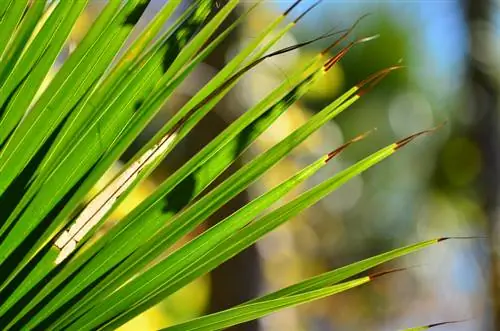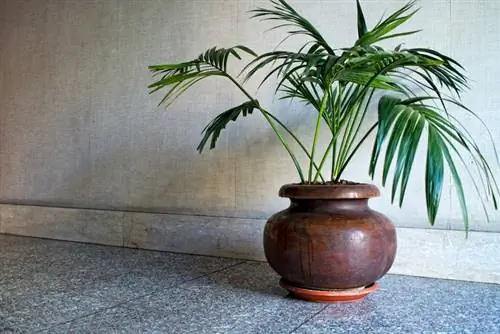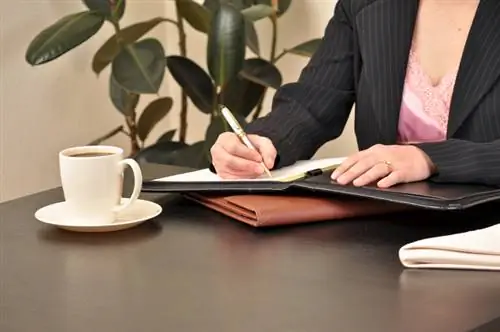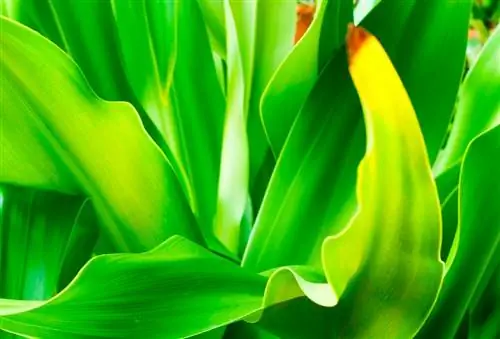- Author admin [email protected].
- Public 2023-12-16 16:46.
- Last modified 2025-01-23 11:20.
Caring for palm trees requires sensitivity because the magnificent plants are very sensitive to care errors. It's not just in winter that you have to water carefully and ensure there is a sufficient amount of airiness. If the tips of the leaves appear brown, this is a clear indication that the attractive plants are no longer in good he alth. Now we need to investigate the causes.

Why does my palm tree have brown tips and how can I care for them?
For palm trees with brown tips, there can be causes such as incorrect location, sunburn, air that is too dry, lack or excess of water, too little substrate or unbalanced fertilization. Adjust the location, water and nutrient supply accordingly to regenerate the plant.
Is the location suitable?
It is often enough to just give the palm tree a different place. The plants need a lot of light to thrive. Even in a partially shaded location it is usually too dark for the plant, the tips of the leaves turn brown and as a result the leaf dies.
Whether in the apartment or outdoors, put the palm tree in one place:
- which is illuminated by the sun for at least five, and preferably more, hours.
- A south-facing window or a south-facing terrace is ideal.
- Make sure that the outdoor area is not shaded by an awning all day long.
- In winter, indoor palms often get too dark. A plant lamp (€89.00 on Amazon) creates balance here.
Sunburn after changing location
Although sunburn usually shows up as spots on the leaves, brown tips can also appear. Plants cultivated outdoors during the summer should therefore be carefully acclimated to the changed conditions. Place the palm tree in a protected, semi-shady place for the first one to two weeks.
Air dryness
The palm species that thrive in desert regions in particular cope well with dry air. However, the conditions in our rooms, which are heated in winter, often do not tolerate these plants and brown leaf tips occur.
The humidity can be increased with simple measures:
- Wet the fronds daily with a sprayer.
- To avoid unsightly limescale stains, only use distilled or boiled water.
- Place a flower pot filled with expanded clay next to the palm tree. If you fill it with water, it will slowly evaporate and increase the humidity in the immediate area.
We ask you to refrain from the frequently heard advice to fill the planter or saucer of the palm tree with the small clay balls. These plants are extremely sensitive to waterlogging and even the wet expanded clay can be too much for them.
Water shortage or excess water
If the palm tree's water balance is out of balance, this will be reflected in brown leaf tips, regardless of whether you have watered too much or too little. When watering, adhere to the following rules:
- Watering is always done when the top few centimeters of soil feel dry (thumb test).
- Water thoroughly until water comes out of the drain hole.
- Tip away excess liquid after a few minutes.
Too little substrate
Palm trees do not need to be repotted very often. However, if there is too little soil available, water can no longer be stored and the plant will dry out despite regular watering.
- Lift the palm tree out of the planter.
- If roots have already appeared that have grown out of the drainage hole, it is high time to place the palm plant in a larger container.
Tip
Unbalanced fertilization is also reflected in brown leaf tips. Only fertilize during the growth phase from March to October. Follow the manufacturer's dosage recommendations exactly.






